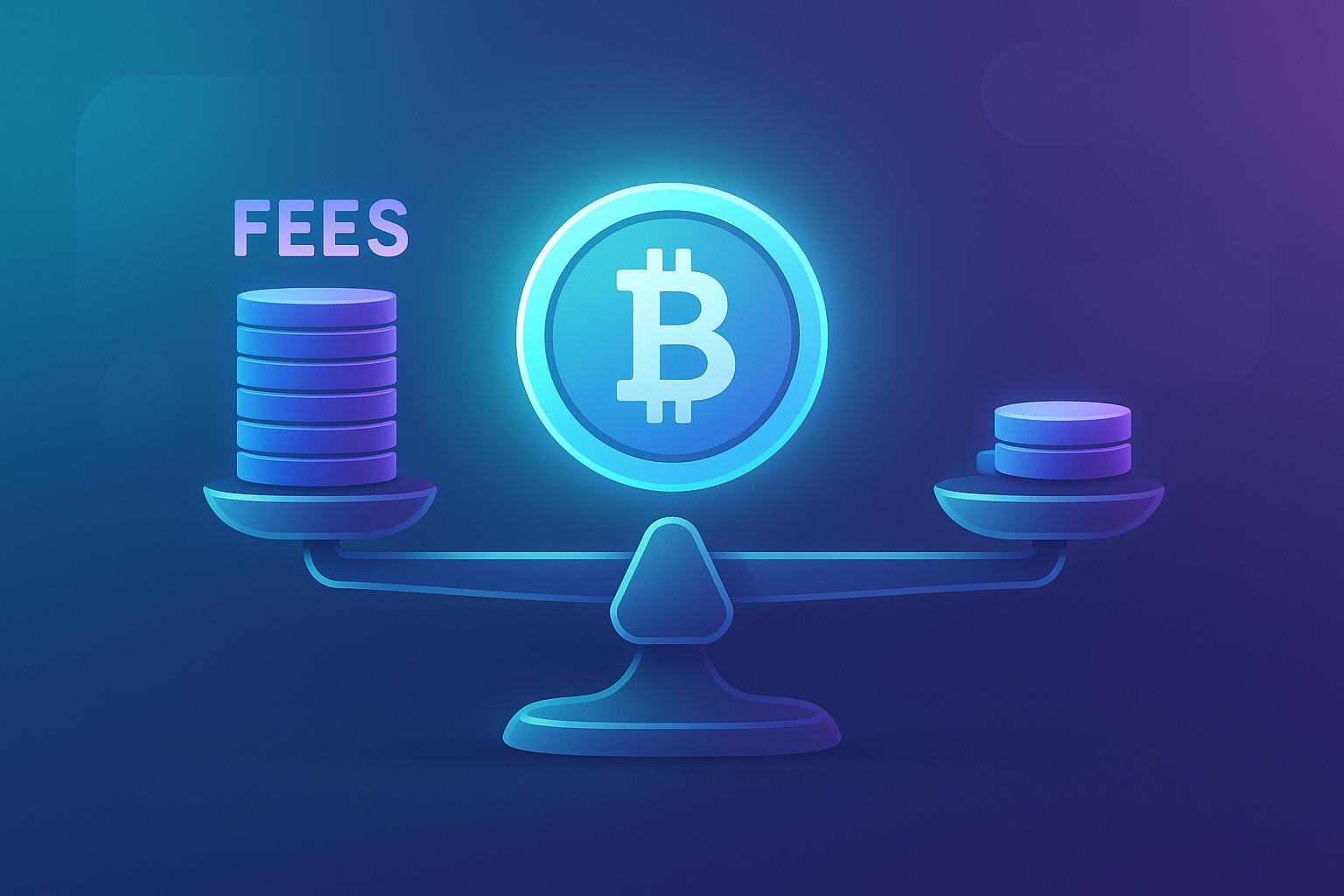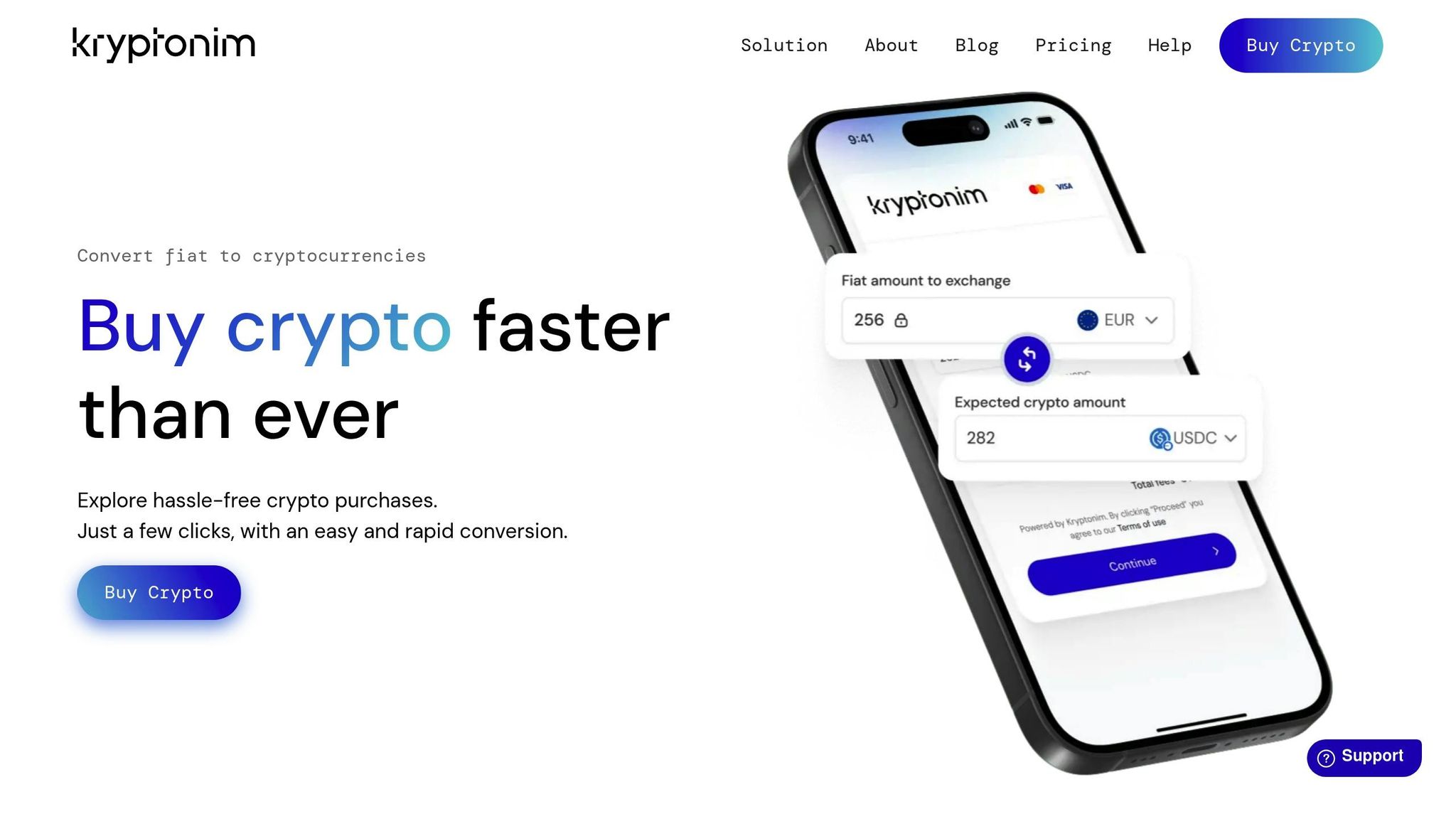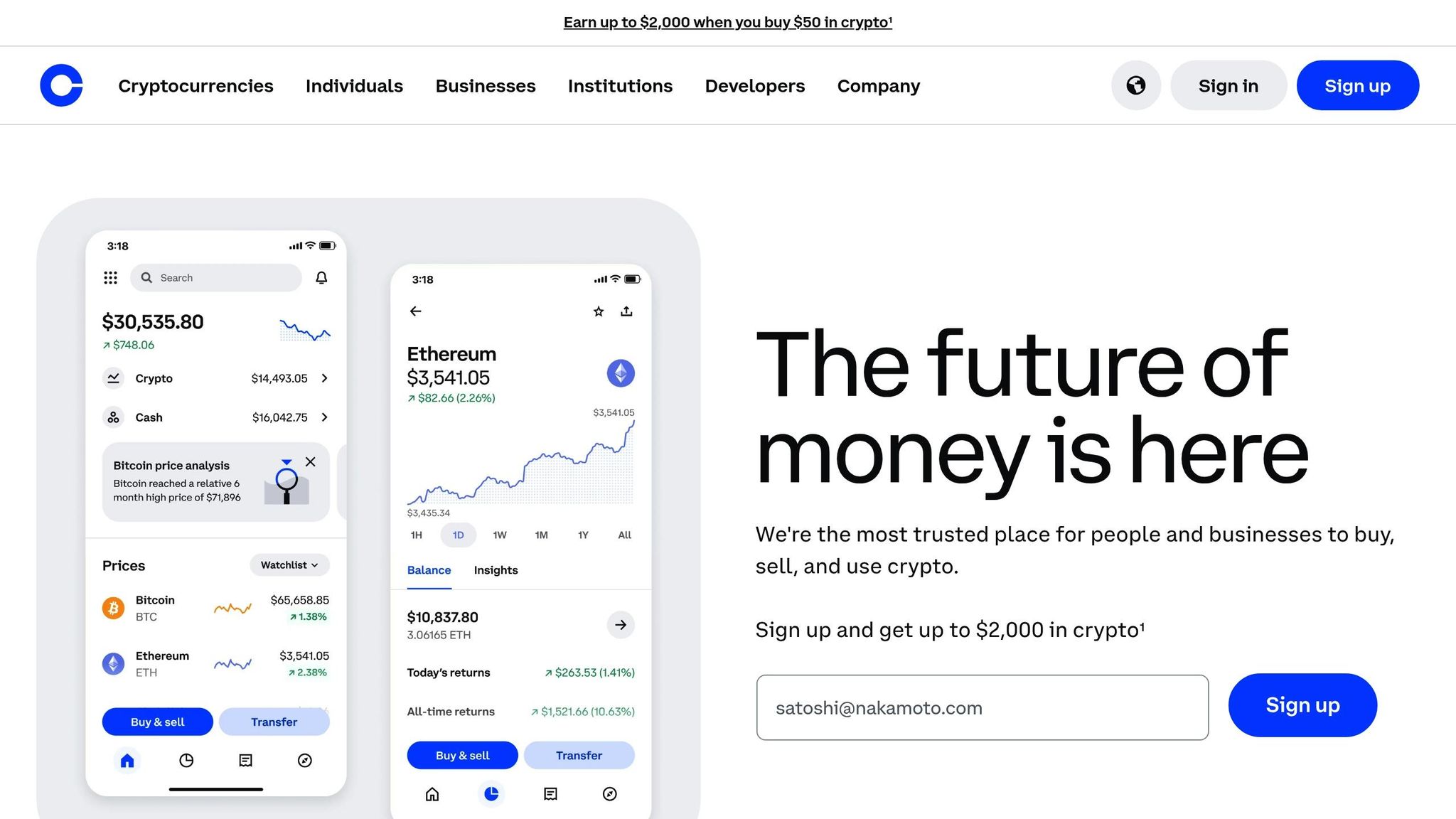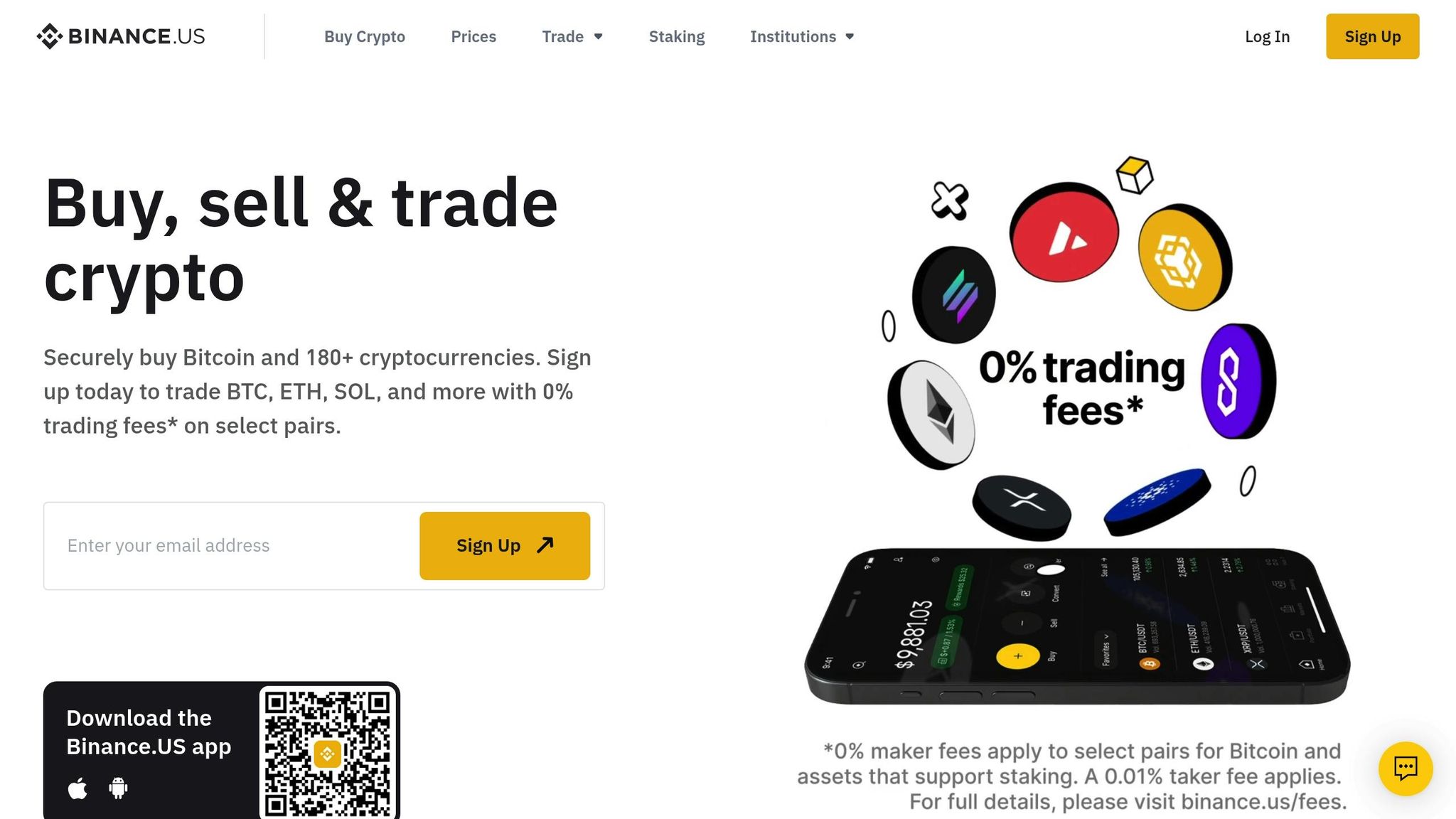High Crypto Exchange Fees? Discover the Cheapest Fiat On-Ramps
Explore affordable options for buying cryptocurrency and compare fees, payment methods, and security features across popular platforms.

Looking for low-cost ways to buy crypto? Here's the deal: fees can eat into your investments fast, especially for beginners. Platforms like Kryptonim, Coinbase, and Binance offer different fee structures, payment methods, and security features.
- Kryptonim: Simple, no-account-required platform with a flat 4% fee for U.S. users. Credit/debit card payments are quick, but bank transfers are only available in EUR.
- Coinbase: User-friendly for beginners, but fees range from 1-3% depending on payment methods. Debit cards cost more, while bank transfers are slower but cheaper.
- Binance: Offers competitive rates with a 2% fee on card payments. Bank transfers are often free, and P2P trading can save on costs but requires extra effort.
Key takeaway: Kryptonim is great for transparency and control, Coinbase for ease of use, and Binance for experienced users seeking flexibility. Choose based on your priorities - fees, speed, or features.
Quick Comparison
| Platform | Fee (Card) | Fee (Bank Transfer) | Security Features | Best For |
|---|---|---|---|---|
| Kryptonim | 4% | N/A (EUR only) | EU-regulated, no account | Privacy, simplicity |
| Coinbase | 1-3% | Lower, but slower | U.S.-regulated, insured | Beginners |
| Binance | 2% | Often free | Custodial, global options | Advanced users |
Pro Tip: Use bank transfers for lower fees and avoid market price changes by choosing faster payment methods.
1. Kryptonim

Kryptonim makes it easy for beginners to buy cryptocurrency without creating an account. This EU-regulated platform focuses on keeping things simple while maintaining strong security measures. Here's a closer look at Kryptonim's standout features and fee structure.
Fee Structure
For U.S. users, Kryptonim applies a 4% fee on each transaction. This fee includes a fixed processing charge and a variable network fee that depends on blockchain traffic. The minimum purchase amount is $10, making it accessible for those looking to start with small investments.
Transparency
Kryptonim takes pride in clear and upfront pricing:
"At Kryptonim, we prioritize transparency in pricing. You'll pay a fair price, with no unexpected or hidden fees."
However, keep in mind that cryptocurrency values can shift between the time you place your order and when the payment is completed. This is especially relevant for slower payment methods, like certain bank transfers, which might result in receiving slightly less crypto.
Payment Methods
U.S. customers can purchase cryptocurrency using credit or debit cards. While bank transfers through Volt are available, they are limited to transactions in EUR and not accessible for U.S. users. Card payments are processed almost instantly, reducing the risk of market price changes affecting your purchase.
Security
As a platform regulated in the EU, Kryptonim complies with strict financial standards. Its no-account-required model enhances privacy by eliminating the need to store personal information. This combination of EU regulation and privacy-focused design ensures a secure and private transaction experience.
2. Coinbase

Coinbase stands out as one of the most well-known cryptocurrency exchanges in the United States, offering a platform that's particularly welcoming to beginners. It provides several ways to buy cryptocurrency, with fees varying based on the payment method you choose. Let's break down its fee structure, payment options, and security measures.
Fee Structure
When it comes to fees, debit card transactions tend to cost more, while bank transfers are more affordable but take longer to process. Fees include a combination of percentages, spreads, and minimum charges for smaller transactions.
Transparency
One thing Coinbase does well is showing a detailed fee breakdown before you finalize a transaction. While this level of clarity is helpful, the combination of spreads and other fees might still feel a bit overwhelming for someone new to crypto. That said, it’s particularly helpful for beginners making small investments, as they can see exactly what they’ll pay upfront.
Payment Methods
For U.S. customers, Coinbase offers several funding options:
- Bank transfers: Lower fees but slower to clear.
- Debit cards: Instant processing but with higher fees.
- Wire transfers: Another option for funding your account.
- PayPal: Convenient for certain transactions.
Security
Coinbase takes security seriously. It’s regulated by U.S. authorities and stores the majority of funds in offline cold storage, which is insured. On top of that, it enforces two-factor authentication and supports mobile biometric logins for an added layer of protection.
3. Binance

For U.S. cryptocurrency enthusiasts, Binance serves as a global exchange platform offering multiple ways to convert traditional money into digital assets. The platform's variety of cost structures and processing times can influence your overall trading expenses, depending on how you choose to fund your account.
Fee Structure
Binance's fees vary based on your chosen payment method. For U.S. users, credit and debit card transactions come with a 2% fee per transaction, making them one of the pricier options for regular purchases. On the other hand, bank transfers often have lower fees or are completely free, offering a more budget-friendly alternative.
Choosing the right payment method can help you balance speed and cost, depending on your priorities. Let’s explore the payment options available for U.S. users.
Payment Methods
Binance supports over 700 payment methods through its peer-to-peer (P2P) service. U.S. customers can fund their accounts via traditional bank transfers, credit cards (VISA/MasterCard), or various online banking options.
The P2P service is particularly appealing for those looking to save on fees, as it often allows direct trading with zero fees. However, this approach requires users to actively connect with trading partners, which might demand more effort compared to other methods.
Transparency
Binance provides detailed fee breakdowns, helping users understand the costs upfront. However, the wide range of options might feel overwhelming to beginners. For example, credit card transactions come with specific limits, including minimum purchase amounts and weekly spending caps. These restrictions are designed to set clear expectations before you proceed with a transaction.
Security
Beyond its competitive fees and extensive payment options, Binance prioritizes security. As a custodial platform, it safeguards user funds through various protective measures and adheres to regulatory standards. That said, regional restrictions may limit access to certain services, and payment method availability can shift due to regulatory changes. It's always a good idea to confirm that your preferred funding method is available in your location before making it part of your regular trading routine.
sbb-itb-0796ce6
Pros and Cons
When choosing a fiat on-ramp, it's essential to weigh the benefits and drawbacks of each platform. These factors can influence both costs and user experience, helping you decide what works best for your needs.
| Platform | Pros | Cons |
|---|---|---|
| Kryptonim | • 0% transaction fees with no hidden spreads or commissions • Non-custodial – you retain control of your crypto • EU-regulated and secure platform • No account creation required • Transparent pricing structure |
• Regional fee structure: 2% per transaction for EU users and 4% for users in other regions |
| Coinbase | • Beginner-friendly interface • Multiple payment options, including ACH, SEPA, cards, e-wallets, and Apple Pay |
• High fees ranging from 1–3% • Hidden spreads that reduce the amount of crypto you receive • Conversion fees on every card spend • Custodial – funds are held on the platform |
| Binance | • Competitive exchange rates • Deep liquidity |
• Interface can be overwhelming for beginners • Regional restrictions may limit access • Custodial – funds are held on the platform • P2P trading requires more effort and active involvement |
Here's a closer look at the trade-offs. Coinbase stands out for its beginner-friendly design and variety of payment options, making it appealing to newcomers. However, its fees - ranging from 1–3% - plus hidden spreads can eat into your crypto purchases over time. Binance, on the other hand, offers competitive rates and deep liquidity, but its complex interface might intimidate less experienced users.
For those keeping a close eye on costs, the fee structure plays a big role. Card purchases often come with extra charges of 3–5%, while bank transfers are usually cheaper but take longer to process.
Another key factor is custody. Non-custodial platforms like Kryptonim give you full control over your crypto, enhancing security and independence. Meanwhile, custodial platforms like Coinbase and Binance hold your funds for you, which can be convenient but may limit access and raise security concerns.
Conclusion
For those in the US looking for an affordable way to step into the crypto world, Kryptonim stands out with its clear 4% fee and no hidden charges. This transparency ensures you're not caught off guard by unexpected costs.
If you're a beginner, Coinbase offers a user-friendly interface to get started, while Binance appeals to seasoned traders with its competitive rates. Keep in mind, though, both platforms operate under custodial models, meaning you won't have full control over your crypto assets.
To keep fees as low as possible, here are some tips:
- Opt for bank transfers instead of credit cards to avoid higher transaction fees.
- Make purchases during off-peak hours to reduce spread-related costs.
- Factor in all fees, including conversion charges, before finalizing your purchase.
For US users who value both affordability and security, Kryptonim offers a solid option. While its 4% fee might initially seem higher, the lack of hidden charges and adherence to EU regulations can lead to considerable savings in the long run.
Choosing a cost-efficient fiat on-ramp can play a key role in maximizing your crypto investment strategy.
FAQs
How does Kryptonim protect my transactions and privacy if I don’t need an account?
Kryptonim puts your security and privacy front and center by using strong encryption and secure protocols to protect your transactions. Plus, because you don’t need an account, your personal information isn’t stored - cutting down the chances of data breaches or unwanted access.
What’s more, Kryptonim keeps things simple and private by handling transactions directly, without involving extra middlemen. This not only ensures your financial activity stays confidential but also upholds top-notch security standards.
What are the risks of using slower payment methods, like bank transfers, to buy cryptocurrency?
When you use slower payment methods, like bank transfers, to buy cryptocurrency, there are some risks to keep in mind. These methods typically take longer to process compared to quicker options such as credit or debit cards. During this waiting period, the price of the cryptocurrency can change, which could impact the value of your purchase.
This delay could also mean missing out on opportunities if you're trying to buy at a specific price. If speed and predictability are important to you, it’s essential to factor in how timing might influence your transaction and investment approach.
How can I choose the best platform for buying crypto with low fees and ease of use?
When choosing a platform that offers both low fees and user-friendly features, start by examining transaction fees and how upfront the platform is about its pricing. Opt for services that clearly display their costs and steer clear of those with hidden fees. While bank transfers are typically more cost-effective, they may take longer compared to other payment methods.
Ease of use is another crucial factor, especially for beginners. A simple, intuitive interface can make navigating the platform much smoother. Also, review the payment options available - common choices include credit/debit cards and bank transfers, but keep in mind that fees and processing times can vary between them. Lastly, consider how quickly you need your cryptocurrency. Instant purchases often come with higher fees, whereas slower options like bank transfers can be more economical.
